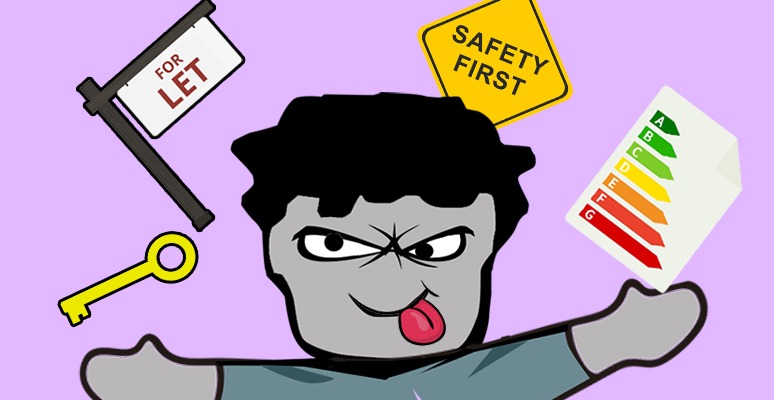
Welcome to the world of HMOs (a.k.a Single lets on steroids)…
The drawbacks: a million confined strangers – in one property – walking on top of one another, elevated maintenance costs, and a tenant turnover rate that will make your toes curl.
The perks (if you can stomach the drawbacks): heightened earning power compared to the traditional Single Lets.
Most HMO operators are experienced landlords that made the leap from Single Let properties to HMOs, simply because they recognise the fact HMOs generate better cash flow and maximise rental income.
However, while the spinning money signs are certainly enticing, and a good enough reason as any to take the leap of faith, there’s still good reason to look into the finer details – because believe you me, HMO’s ain’t for every Tom, Dick and Harry.
Just to clarify, I’m not here to sell or discourage, I’m just airing my humble opinion like someone cares.
Page contents
What is a HMO (by definition)?
Ok, so real quick now, the definition of HMO according to the GOV:
Your home is a house in multiple occupation (HMO) if both of the following apply:
- at least 3 tenants live there, forming more than 1 household
- you share toilet, bathroom or kitchen facilities with other tenants
A household is defined as either a single person or members of the same family who live together. A ‘family’ includes people who are:
- married or living together – including people in same-sex relationships
- relatives or half-relatives, for example grandparents, aunts, uncles, siblings
- step-parents and step-children
A property is NOT a HMO where only 2 individuals are living and sharing facilities, regardless of whether the landlord lives in the property or not. If the landlord does live in the property (and there are two tenants), then the two strays are most likely lodgers.
An HMO is normally…
- A house split into separate bedsits
- A hostel
- A bed-and-breakfast hotel that is not just for holidays
So now we’ve covered the basics, let’s get to the meat and potatoes of HMOs…
HMO Tenancy Agreements
Most HMO landlords will issue their tenants with an assured shorthold tenancy agreement (AST), just like you would with regular single lets.
All the usual AST practises apply, but there are a couple of points specific to HMO’s you may want to consider, which I’ve discussed in my HMO Shorthold Tenancy Agreements Guide.
Advantages & Disadvantages of HMOs
Advantages
- Cash flow! It’s all about the money! Rental yields for HMOs are typically much higher than standard Single Lets (as much as three times higher).
- Demand for single room lets are in huge demand right now due to tenants being priced out of the traditional rental market. You shouldn’t have any problems filling the spaces, unless you’re trying to flog an absolute shithole.
- If one dead-beat tenant vacates or falls into arrears, you will still receive rent from the other tenants.
- There can be tax advantages due to greater costs to offset.
- The HMO model is relatively stable during recessions, because when people face hard times, house sharing is one of the cheapest means of putting a roof over your head.
Disadvantages
- High tenant turnover.
- Greater risk of damage, which means more expenses on maintenance and repairs.
- Running costs are generally higher.
- Rent collection from several individuals, which equates to more pesky admin work.
- Greater risk of domestic conflict between tenants (which is common in HMO, which isn’t really surprising, bearing in the mind that the model is largely based on strangers living together).
- Requires more management and time.
- There are more regulations with HMO’s landlords have to comply with compared to Single Lets, particularly regarding safety aspects. This is covered in:
- Capital growth can sometimes be lower on converted HMO’s, because the resale value of them are typically lower than regular houses.
- Higher start up costs because furniture needs to be supplied.
As you can very well see, the list of disadvantages cast a shadow over the futile list of advantages. However… the rental yield. The sweet heightened rental yield.
HMO Landlord Responsibilities
HMO landlords are typically responsible for the following:
- Complying with this list of HMO legal requirements.
- Providing and maintaining all fixtures, fittings and white goods
- Fully furnishing the property
- Maintaining communal areas and repairing damaged furnishings and items in communal areas. This may entail providing a regular cleaning service for the shared areas e.g. kitchen, bathrooms, hallways etc.
- Paying council tax and utility bills. While this isn’t essential, most HMO tenants prefer it if the landlord manages and pays the bills
- Providing broadband
Licensing for HMOs
This is one of the most important aspects of running a HMO – landlords MUST obtain a HMO licence if one is required (not all HMOs require one), and also renewed before expiration (they usually need renewing every 5 years, but can vary by borough).
Your local authority should be able to provide you with information on how to acquire a licence, and which licence(s) you require, and how much it costs. From my experience, they usually cost between £100 to £200 per year.
A licence can only be ‘granted’ – most councils have a proactive inspection programme of HMOs, which often involves a home visit by an inspector to ensure the property is suitable for HMO.
If the condition of the property is not up to standard, the landlord or owner is required to improve them before they will be granted a licence.
A licence will normally be granted if…
Generally, as long as you meet your legal obligations (as listed above), you should be granted a licence:
- Appropriate fire safety measures are in place (ask your local council for details)
- Annual gas safety checks are up-to-date
- The electrical wiring and appliances have been checked and certified as safe every five years
- The property is not overcrowded
- There are adequate cooking and washing facilities
- Communal and shared areas are kept clean and in good repair
- There are appropriate storage and disposal facilities
The council will usually only refuse to grant a licence if they have serious concerns about how the HMO will be managed.
Failing to acquire a valid HMO licence before letting is a criminal offence, and non-compliance can lead to hefty financial penalties, and it could also mean that your tenants will be required to vacate the premises.
Unlicensed HMOs
As mentioned, not all HMOs require a license (it will vary by each local authority).
HMOs that do not require a license is referred to as an “unlicensed HMO”
For all intents and purposes, an unlicensed HMO is still an HMO, but simply, they do not meet the mandatory licensing criteria (for whatever reason).
Unlicensed or otherwise, all HMO legal obligations should still be complied with.
Disclaimer: I'm just a landlord blogger; I'm 100% not qualified to give legal or financial advice. I'm a doofus. Any information I share is my unqualified opinion, and should never be construed as professional legal or financial advice. You should definitely get advice from a qualified professional for any legal or financial matters. For more information, please read my full disclaimer.


 Landlord Products / Services
Landlord Products / Services







![How To Get A HMO Property Ready For Renting [Checklist] How To Get A HMO Property Ready For Renting [Checklist]](https://www.propertyinvestmentproject.co.uk/wp-content/uploads/HMO-Checklist.jpg)





















